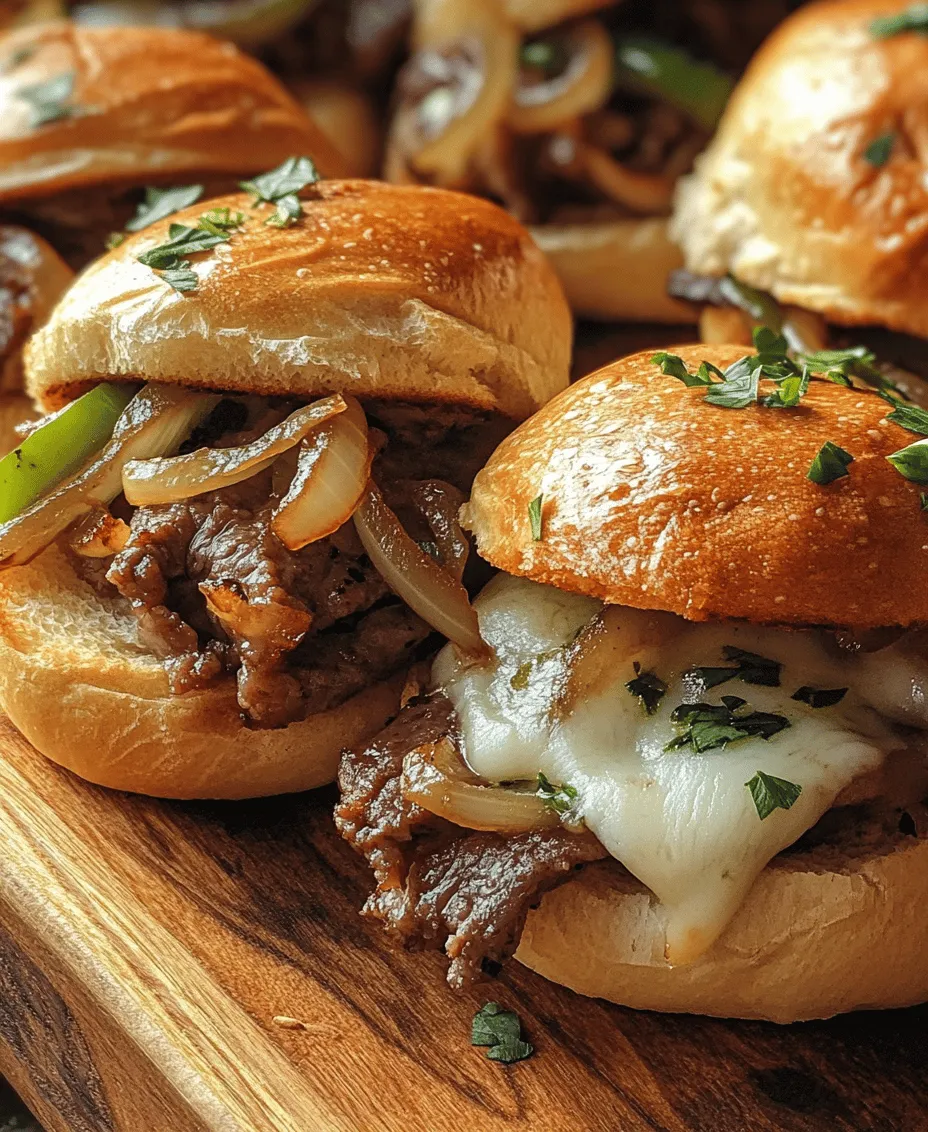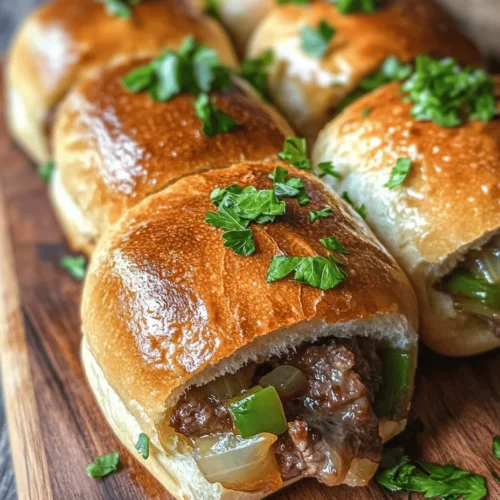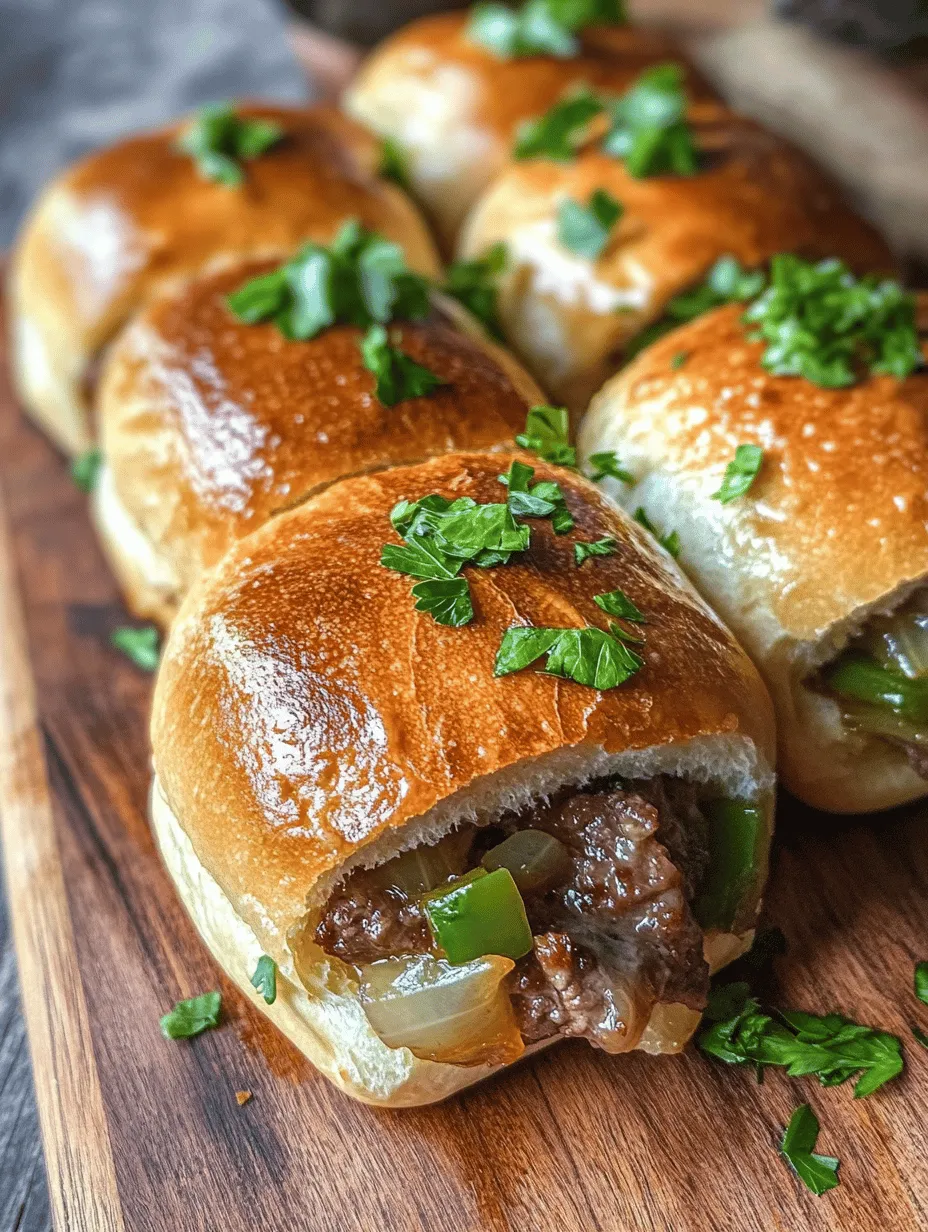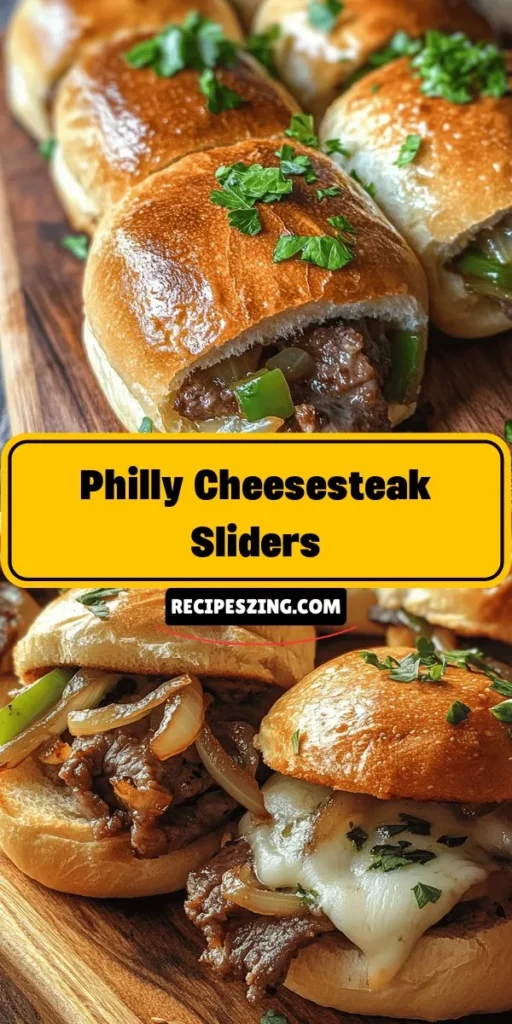Philly cheesesteak sliders are a delightful twist on the classic Philadelphia sandwich, combining tender ribeye steak, sautéed vegetables, and gooey cheese, all nestled in soft, sweet rolls. These bite-sized delights pack all the flavor of the traditional cheesesteak into a more manageable form, making them perfect for parties, game days, or a cozy family dinner. Easy to make and incredibly satisfying, these sliders are sure to be a hit wherever they’re served. In this article, we’ll explore the history of cheesesteaks, the ingredients that make this recipe special, and provide a detailed step-by-step guide to preparing these mouthwatering sliders.
The Origins of Philly Cheesesteak
Understanding the roots of the Philly cheesesteak adds depth to any recipe. The cheesesteak sandwich originated in Philadelphia in the 1930s. According to various sources, Pat Olivieri, a hot dog vendor, first created the sandwich by grilling some beef and placing it on an Italian roll. He served it to a cab driver who was so impressed that he spread the word, leading to the sandwich’s popularity.
Over the decades, the cheesesteak evolved from a humble street food to a beloved classic, with many establishments competing for the title of the best cheesesteak in the city. Iconic spots like Pat’s King of Steaks and Geno’s Steaks have become landmarks in Philadelphia, drawing locals and tourists alike to indulge in this savory pleasure. The cheesesteak’s significance extends beyond its delicious taste; it represents a piece of Philadelphia’s culinary identity and culture.
Today, the cheesesteak is celebrated far beyond its city of origin. Variations abound, with countless chefs and home cooks putting their own spin on the recipe. Yet, the heart of the cheesesteak remains the same, consisting of thinly sliced beef, sautéed onions, and cheese melted to perfection, all served in a fresh roll. With the introduction of sliders, this classic has taken on a new life, offering a fun and shareable way to enjoy the iconic flavors.
Ingredients Overview
Creating irresistible Philly cheesesteak sliders starts with understanding the key components that come together to create this mouthwatering dish.
High-Quality Ribeye Steak
At the heart of any great cheesesteak is the beef, and for sliders, ribeye steak is the preferred choice. Ribeye is known for its rich marbling, which contributes to the meat’s tenderness and flavor. When cooked properly, ribeye provides a juicy and savory bite that perfectly complements the other ingredients. When selecting ribeye, look for cuts that are well-marbled for the best results.
The Role of Vegetables
Onions and bell peppers are traditional accompaniments in a Philly cheesesteak, and they play a crucial role in enhancing the overall flavor profile of the sliders. Sautéed onions add a sweet, caramelized depth, while bell peppers introduce a slight crunch and vibrant color. Choosing fresh, high-quality vegetables ensures that your sliders will be bursting with flavor.
Cheese Selection
No cheesesteak is complete without cheese, and provolone is the cheese of choice for many enthusiasts. Its mild flavor melts beautifully, creating a creamy texture that binds the ingredients together. Alternatively, some people prefer Cheez Whiz for its unique, gooey consistency, while others opt for American cheese. Whatever cheese you choose, make sure it melts well to achieve that signature cheesesteak experience.
The Benefit of Using Sweet Hawaiian Rolls
The choice of bread is equally important, and sweet Hawaiian rolls are an excellent option for sliders. Their slightly sweet flavor and soft texture provide a delightful contrast to the savory filling. Plus, their size makes them perfect for sliders, allowing for easy handling and a satisfying bite. If Hawaiian rolls aren’t available, any soft dinner roll can work, but the sweetness of the Hawaiian variety truly elevates the dish.
Additional Seasonings
To enhance the flavor of the sliders, consider using additional seasonings. A sprinkle of garlic powder or a dash of Worcestershire sauce can add an extra layer of depth to the meat. Additionally, black pepper and salt should be used to season both the meat and vegetables, ensuring that every component is well-balanced and flavorful.
Preparation Steps
Now that we’ve covered the ingredients, let’s dive into the preparation steps to create your Philly cheesesteak sliders from start to finish.
Preparing the Ingredients
Before you start cooking, it’s essential to prepare all your ingredients. Start by slicing the ribeye steak into thin strips. For the best results, place the steak in the freezer for about 30 minutes before slicing; this firms up the meat and makes it easier to cut thinly. Aim for slices that are about 1/8 inch thick for optimal tenderness.
Next, slice the onions and bell peppers. For the onions, a medium-sized yellow onion works well, and you can cut them into thin half-moons. As for the bell peppers, any color will do, but a combination of red and green adds both flavor and visual appeal. Slice them into thin strips to ensure they cook evenly and blend seamlessly with the steak.
Tips for Slicing Ribeye Steak
When slicing ribeye, always cut against the grain. The grain refers to the direction in which the muscle fibers run, and cutting against it helps to break down the fibers, resulting in a more tender bite. Make sure your knife is sharp, as this will make the process smoother and more efficient.
How to Properly Prepare Onions and Bell Peppers
Once you’ve sliced the vegetables, it’s time to cook them. Start by heating a large skillet over medium heat and adding a tablespoon of olive oil. Once the oil is heated, add the sliced onions and bell peppers, stirring occasionally. Sauté for about 5-7 minutes or until the vegetables are softened and caramelized. For an added flavor boost, consider seasoning them with a pinch of salt and pepper as they cook.
Cooking the Steak
After the vegetables are nicely sautéed, it’s time to cook the steak. In the same skillet, increase the heat to medium-high and add another tablespoon of olive oil if needed. Once the oil is shimmering, add the sliced ribeye steak in a single layer. It’s important not to overcrowd the pan; if necessary, work in batches.
Cook the steak for about 2-3 minutes without stirring to allow it to sear properly. Then, flip the meat and continue cooking until it is browned and just cooked through. This should take another 2-3 minutes. The key is to achieve a nice caramelization on the outside while keeping the inside tender.
Ideal Skillet Temperature for Perfect Browning
Achieving the ideal skillet temperature is essential for perfect browning and flavor development. If the skillet is too hot, the meat may burn before it has a chance to cook through. Conversely, if it’s not hot enough, the steak will steam rather than sear. Aim for a medium-high heat, adjusting as necessary to maintain a steady cooking temperature.
Seasoning Tips for Maximum Flavor
As the steak cooks, season it with salt, pepper, and any additional spices you prefer. A splash of Worcestershire sauce can also be added at this stage to give the meat a savory umami flavor. Be sure to taste and adjust the seasoning as needed, ensuring that the steak is well-flavored before moving on to the next step.
Sautéing the Vegetables
Once the steak is cooked, return the sautéed onions and bell peppers to the skillet, combining everything thoroughly. This allows the flavors to meld while ensuring that the vegetables are heated through. If you want to add cheese at this stage, you can sprinkle it over the top and cover the skillet for a minute or two to let it melt.
The Importance of Texture in the Final Dish
Texture plays a critical role in the enjoyment of Philly cheesesteak sliders. The combination of tender ribeye, soft sautéed vegetables, and gooey melted cheese creates a satisfying mouthfeel that elevates the dish. When assembling the sliders, be mindful of balancing the filling so that each slider delivers that perfect bite.
With these preparation steps, you’re well on your way to creating delicious Philly cheesesteak sliders that will impress friends and family alike. As we move forward, we’ll discuss the assembly and serving of these delightful sliders, ensuring that every detail is covered for a truly outstanding culinary experience. Stay tuned for the next part of this article, where we’ll dive into the final touches and tips for serving these delectable treats.

How to Achieve the Perfect Caramelization
Caramelization is a crucial step in developing the rich, sweet flavor profile that makes Philly Cheesesteak Sliders so irresistible. To achieve that perfect caramelization, focus on the following techniques when preparing your onions and peppers:
1. Use the Right Pan: A heavy-bottomed skillet or cast-iron pan provides even heat distribution, which is essential for caramelization. Avoid non-stick pans; they don’t allow for the necessary browning.
2. Temperature Control: Start with medium heat to soften the vegetables and then gradually increase to medium-high. This allows the natural sugars in the onions to caramelize without burning. Stir occasionally to avoid sticking and ensure even cooking.
3. Patience is Key: Caramelization takes time. Allow the onions to cook for about 15-20 minutes until they are golden brown and sweet. If they start to burn, lower the heat. You can also add a splash of water or broth to help deglaze the pan if necessary.
4. Season as You Go: Seasoning your onions and peppers with a pinch of salt during cooking can enhance their sweetness and aid in the caramelization process.
Assembling the Sliders
Once your steak, caramelized onions, and peppers are ready, it’s time to assemble your sliders for the best flavor and presentation.
Tips for Slicing Slider Rolls
– Choose Fresh Rolls: Start with soft, fresh slider rolls, ideally ones that are slightly crusty on the outside but fluffy on the inside. Common choices include Hawaiian rolls or mini baguettes.
– Cut Carefully: Slice the rolls horizontally, keeping them attached at the back. This makes it easier to fill them without spilling ingredients.
– Toast for Texture: Lightly toast the insides of the rolls in the oven or on the stovetop before assembly. This adds texture and helps prevent sogginess from the filling.
Layering the Steak and Vegetables for Balanced Flavor
1. Bottom Layer: Begin by placing a generous layer of the sautéed steak on the bottom half of each roll. This creates a solid base for the rest of the ingredients.
2. Add Vegetables: Next, add a layer of the caramelized onions and peppers. Distributing them evenly ensures every bite is flavorful.
3. Top it Off: Finish with a slice of cheese, ensuring that it covers the steak and vegetables adequately. Provolone or Cheez Whiz are traditional choices, but feel free to use any melty cheese you prefer.
Cheese Distribution and Its Importance
Proper cheese distribution is key to achieving that iconic melty texture. Make sure to cover the steak and vegetables completely with cheese. If using shredded cheese, ensure it’s evenly spread across the filling. This ensures that every slider has that creamy, gooey mouthfeel that complements the savory flavors of the meat and vegetables.
Baking the Sliders
Baking the sliders is the final step that brings everything together, resulting in a melty, golden delight.
Oven Settings and Timing for Best Results
1. Preheat Your Oven: Set your oven to 350°F (175°C). This temperature allows the cheese to melt without overcooking the bread.
2. Baking Time: Place the assembled sliders on a baking sheet and bake for 15-20 minutes or until the cheese is melted and bubbly.
What to Look for When Determining Doneness
Keep an eye on your sliders as they bake. The cheese should be completely melted and slightly golden. The bread should also be lightly toasted, with a golden hue but not dried out. If the tops of the rolls are browning too quickly, you can cover them with aluminum foil to prevent burning.
Importance of Resting Sliders Before Serving
After baking, let the sliders rest for about 5 minutes before serving. This allows the cheese to set slightly, making it easier to cut and serve without losing all the filling. Resting also enhances the flavors and helps the sliders hold together better.
Serving Suggestions
Elevate your Philly cheesesteak slider experience with these serving ideas:
Ideal Accompaniments for Sliders
– Dipping Sauces: Serve with a side of creamy ranch or a zesty horseradish sauce for an added kick.
– Pickles and Chips: Crunchy pickles and potato chips make for great sides that complement the sliders.
Creative Serving Presentations
– Platter Display: Arrange the sliders on a large platter and garnish with fresh parsley or sliced green onions for a pop of color.
– Slider Stands: Use small wooden or metal stands to hold the sliders upright, adding a rustic touch to your presentation.
Pairing Ideas: Sides and Beverages
– Sides: Consider pairing with a fresh green salad, sweet potato fries, or coleslaw for a well-rounded meal.
– Beverages: Complement your sliders with a cold craft beer or a refreshing iced tea, balancing the rich flavors of the dish.
Customization Options for Different Tastes
Feel free to customize the sliders based on personal preferences. For a spicy twist, add sliced jalapeños or a drizzle of hot sauce. To make them vegetarian-friendly, consider using sautéed mushrooms or grilled vegetables in place of steak.
Nutritional Information
Understanding the nutritional profile of your Philly cheesesteak sliders can help you enjoy them responsibly.
Breakdown of Calories, Fats, and Proteins per Slider
On average, each slider contains approximately:
– Calories: 250-300 calories
– Fats: 12-18 grams
– Proteins: 12-15 grams
These numbers can vary based on the specific ingredients and portion sizes used in the recipe.
Potential Health Considerations
While delicious, traditional cheesesteak sliders can be high in sodium and saturated fats. If you’re monitoring your intake, consider using leaner cuts of beef and low-fat cheese options.
Suggestions for Making the Recipe Lighter
To lighten the recipe, you can:
– Use Whole Wheat Rolls: Opt for whole grain or whole wheat slider rolls for added fiber.
– Lean Meat Choices: Choose lean cuts of beef, such as sirloin, to reduce fat content.
– Vegetable Substitutes: Increase the amount of vegetables and decrease the meat for a healthier balance.
Conclusion
Philly cheesesteak sliders are a flavorful, convenient way to enjoy a classic dish in a new format. This recipe offers a perfect balance of textures and flavors, making it an appealing choice for any occasion. Whether you’re hosting a gathering or simply looking for a satisfying meal, these sliders are sure to please everyone at the table. With the right ingredients, preparation, and presentation, you can bring the essence of Philadelphia right into your kitchen.
Get ready to indulge in this savory delight, and don’t forget to customize your sliders to suit your taste. With every bite, you’ll experience the melt-in-your-mouth goodness that defines the beloved cheesesteak, all served in a fun and shareable slider format!



